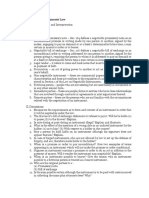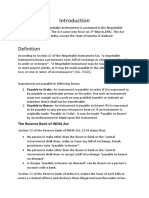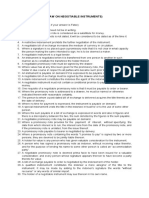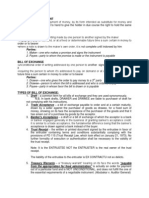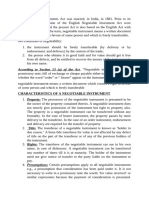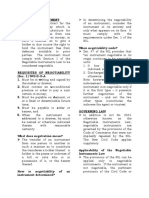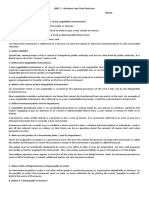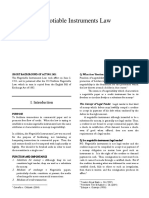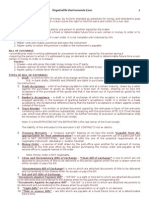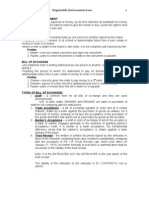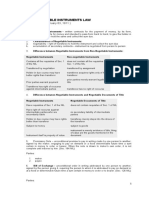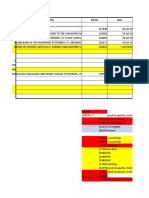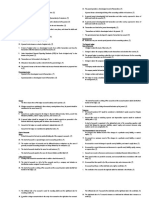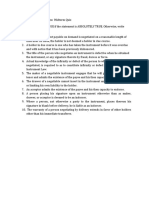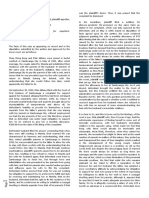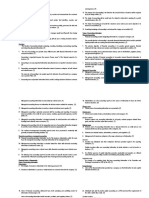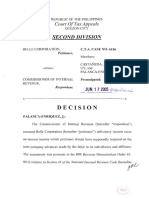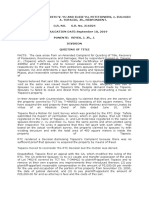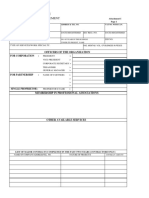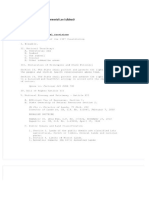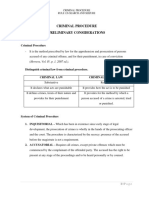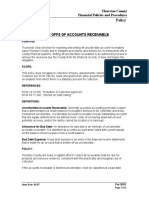0 ratings0% found this document useful (0 votes)
51 viewsQuiz 1 Prelims
Quiz 1 Prelims
Uploaded by
RewsEnThis document contains 20 true/false questions about negotiable instruments law:
1. A letter of credit, postal money order, and certificate of stock are negotiable instruments, while a bill of lading, warehouse receipt, and treasury warrant are non-negotiable.
2. A promissory note is defined as an unconditional written promise by one person to pay another a certain sum of money.
3. The key elements of a negotiable instrument are that it must be in writing, contain an unconditional promise to pay a certain sum, and be payable either on demand or at a fixed time.
Copyright:
© All Rights Reserved
Available Formats
Download as DOCX, PDF, TXT or read online from Scribd
Quiz 1 Prelims
Quiz 1 Prelims
Uploaded by
RewsEn0 ratings0% found this document useful (0 votes)
51 views1 pageThis document contains 20 true/false questions about negotiable instruments law:
1. A letter of credit, postal money order, and certificate of stock are negotiable instruments, while a bill of lading, warehouse receipt, and treasury warrant are non-negotiable.
2. A promissory note is defined as an unconditional written promise by one person to pay another a certain sum of money.
3. The key elements of a negotiable instrument are that it must be in writing, contain an unconditional promise to pay a certain sum, and be payable either on demand or at a fixed time.
Original Description:
nego
Original Title
QUIZ 1 PRELIMS
Copyright
© © All Rights Reserved
Available Formats
DOCX, PDF, TXT or read online from Scribd
Share this document
Did you find this document useful?
Is this content inappropriate?
This document contains 20 true/false questions about negotiable instruments law:
1. A letter of credit, postal money order, and certificate of stock are negotiable instruments, while a bill of lading, warehouse receipt, and treasury warrant are non-negotiable.
2. A promissory note is defined as an unconditional written promise by one person to pay another a certain sum of money.
3. The key elements of a negotiable instrument are that it must be in writing, contain an unconditional promise to pay a certain sum, and be payable either on demand or at a fixed time.
Copyright:
© All Rights Reserved
Available Formats
Download as DOCX, PDF, TXT or read online from Scribd
Download as docx, pdf, or txt
0 ratings0% found this document useful (0 votes)
51 views1 pageQuiz 1 Prelims
Quiz 1 Prelims
Uploaded by
RewsEnThis document contains 20 true/false questions about negotiable instruments law:
1. A letter of credit, postal money order, and certificate of stock are negotiable instruments, while a bill of lading, warehouse receipt, and treasury warrant are non-negotiable.
2. A promissory note is defined as an unconditional written promise by one person to pay another a certain sum of money.
3. The key elements of a negotiable instrument are that it must be in writing, contain an unconditional promise to pay a certain sum, and be payable either on demand or at a fixed time.
Copyright:
© All Rights Reserved
Available Formats
Download as DOCX, PDF, TXT or read online from Scribd
Download as docx, pdf, or txt
You are on page 1of 1
QUIZ 1
NEGOTIABLE INSTRUMENTS LAW
TRUE OR FALSE: Write TRUE if the statement is ABSOLUTELY TRUE; otherwise write
FALSE. NO ERASURES ALLOWED.
1. A letter of credit is a negotiable instrument.
2. A Treasury warrant is a non-negotiable instrument.
3. A Postal Money order is a negotiable instrument.
4. A Bill of Lading is a non-negotiable instrument.
5. A Certificate of Stock is a negotiable instrument.
6. A Warehouse receipt is a non-negotiable instrument.
7. A promissory note is an unconditional promise in writing made by one person to another
signed by the maker, engaging to pay on demand, or at a fixed or determinable future
time, a sum certain in money, to order or to bearer.
8. A non-negotiable instrument is an instrument which does not comply with Section 1 of
the Negotiable Instruments Law.
9. When a negotiable instrument is transferred from one person to another, such that the
transferee becomes the holder of the instrument, it is called an assignment.
10. Indorsement is the transfer of possession, actual or constructive, from one person to
another.
11. Holder means the payee or indorsee of a bill or a note, who is in possession of it, or the
bearer thereof.
12. Issue means the first delivery of the instrument, complete in form, to a person who takes
it as a holder.
13. A bill of exchange is an order instrument.
14. A promissory note is a bearer instrument.
15. The parties in a promissory note are the maker and the drawer.
16. The parties in a bill of exchange are the, drawer, the drawee and the payee.
17. A negotiable instrument must always be in writing.
18. A negotiable instrument must contain an unconditional promise or order to pay a sum
certain in money.
19. A negotiable instrument must be payable on demand.
20. Where the instrument is addressed to a drawee, he must be named or otherwise indicated
therein.
You might also like
- Negotiable Instrument Hand OutsDocument51 pagesNegotiable Instrument Hand OutsHenry Jones UrsalesNo ratings yet
- Labor Rev - Case DigestsDocument16 pagesLabor Rev - Case DigestsRewsEn100% (1)
- Case Digests - Labor Rev - Atty LorenzoDocument90 pagesCase Digests - Labor Rev - Atty LorenzoRewsEn50% (2)
- Presented By: Nishant JainDocument22 pagesPresented By: Nishant JainNishant JainNo ratings yet
- Reviewer in NegoDocument9 pagesReviewer in NegoMhayBinuyaJuanzonNo ratings yet
- Negotiable InstrumentsDocument4 pagesNegotiable InstrumentsShamaarajShankerNo ratings yet
- NIL Intro and Sec. 1 ReviewerDocument5 pagesNIL Intro and Sec. 1 ReviewerSamantha ReyesNo ratings yet
- Negotiable Instruments ActDocument15 pagesNegotiable Instruments ActParag Darwade100% (2)
- Negotiable Instruments ActDocument18 pagesNegotiable Instruments Acttouhiddewan2No ratings yet
- Law Relating To Negotiable InstrumentDocument4 pagesLaw Relating To Negotiable InstrumentBikrOm BaRuaNo ratings yet
- Nego Finals ReviewerDocument22 pagesNego Finals ReviewerAnna Katrina VistanNo ratings yet
- VII. Law On Negotiable InstrumentsDocument17 pagesVII. Law On Negotiable InstrumentsJayvee M FelipeNo ratings yet
- Nil StudentsDocument10 pagesNil StudentsJohn Rey Bantay RodriguezNo ratings yet
- Negotiable Instruments Qanda NotesDocument20 pagesNegotiable Instruments Qanda NotesRamon Joma BungabongNo ratings yet
- The Negotiable Instrument Act, 1881Document18 pagesThe Negotiable Instrument Act, 1881GarimaNo ratings yet
- Lab Unit-2 PDFDocument29 pagesLab Unit-2 PDFjaiminmistry.vtcbcsrNo ratings yet
- Law Reviewer PDFDocument38 pagesLaw Reviewer PDFNICAEL ARVIN VALMONTENo ratings yet
- Chapter 1Document6 pagesChapter 1Andrei ArkovNo ratings yet
- Negotiable Instrument Act Module 4Document20 pagesNegotiable Instrument Act Module 4SANAT MishraNo ratings yet
- BLW 302 Midterm ExamDocument1 pageBLW 302 Midterm ExamTatine AvelinoNo ratings yet
- NEGO Part1 by k2Document3 pagesNEGO Part1 by k2'atsirk-sinu AlemaniaNo ratings yet
- A Negotiable Instrument Is A Signed Document That Promises A Sum of Payment To A Specified Person or An AssigneeDocument13 pagesA Negotiable Instrument Is A Signed Document That Promises A Sum of Payment To A Specified Person or An AssigneeabhinandklgdNo ratings yet
- NEGOTIABLE INSTRUMENTS ACTDocument15 pagesNEGOTIABLE INSTRUMENTS ACTKaninica BanerjeeNo ratings yet
- Negotiable Instruments Non-Negotiable InstrumentsDocument7 pagesNegotiable Instruments Non-Negotiable InstrumentsCyberR.DomingoNo ratings yet
- Negotiable Instrument ActDocument9 pagesNegotiable Instrument ActHimanshu DarganNo ratings yet
- Concept of Negotiable InstrumentsDocument6 pagesConcept of Negotiable InstrumentsJemmieNo ratings yet
- LCC Nego-InstrumentDocument80 pagesLCC Nego-Instrumentandeng.huerto07No ratings yet
- Negotiable InstrumentsDocument6 pagesNegotiable Instrumentskero keropiNo ratings yet
- Reviewer in NegoDocument7 pagesReviewer in NegoJoan BartolomeNo ratings yet
- Nil-Riel Villalon: Uniformity in The Laws of The Different States Upon This Important Subject, So That TheDocument7 pagesNil-Riel Villalon: Uniformity in The Laws of The Different States Upon This Important Subject, So That TheBobby ParksNo ratings yet
- Negotiable Instruments LawDocument23 pagesNegotiable Instruments LawPhilippe AmbasNo ratings yet
- Sbec - Final ExercisesDocument7 pagesSbec - Final ExercisesJULLIE CARMELLE H. CHATTONo ratings yet
- UNIT 4 NotesDocument8 pagesUNIT 4 NotesPiyush SinglaNo ratings yet
- Negotiable Instruments LawDocument45 pagesNegotiable Instruments LawJay ArNo ratings yet
- RELEBUS - Negotiable Instrument (Part 1)Document10 pagesRELEBUS - Negotiable Instrument (Part 1)Abby Gail TiongsonNo ratings yet
- Neglaw EpassfinalDocument68 pagesNeglaw EpassfinalrdNo ratings yet
- Nego 2nd WeekDocument35 pagesNego 2nd WeekElyn ApiadoNo ratings yet
- 2008 Lei NegoDocument50 pages2008 Lei NegoDave SolarisNo ratings yet
- 57 - Negotiable Instrument ActDocument20 pages57 - Negotiable Instrument ActVijaya BanuNo ratings yet
- Commercial Law Review: Maria Zarah Villanueva - CastroDocument28 pagesCommercial Law Review: Maria Zarah Villanueva - CastroMia VinuyaNo ratings yet
- Business Law: Certificate LevelDocument14 pagesBusiness Law: Certificate LevelRafidul IslamNo ratings yet
- Nego Finals ReviewerDocument22 pagesNego Finals ReviewerJay-ArhNo ratings yet
- BUSINESS LAW Unit 5Document23 pagesBUSINESS LAW Unit 5Deepak TongliNo ratings yet
- Chapter 1: General Considerations: ExceptionsDocument54 pagesChapter 1: General Considerations: ExceptionsArjan Jay Arsol ArcillaNo ratings yet
- Act 2031, 03 February 1911 Sec. 60, New Central Bank Act, R.A. 7653 Art. 1249, CCDocument57 pagesAct 2031, 03 February 1911 Sec. 60, New Central Bank Act, R.A. 7653 Art. 1249, CCrdNo ratings yet
- Unit - 2 Negotiable Instruments: Kantharaju N.P. Ananya Institute of Commerce and ManagementDocument9 pagesUnit - 2 Negotiable Instruments: Kantharaju N.P. Ananya Institute of Commerce and ManagementvasistaharishNo ratings yet
- Learning ObjectivesDocument11 pagesLearning ObjectivesWendyMayVillapaNo ratings yet
- Ni PDFDocument67 pagesNi PDFShubham SharmaNo ratings yet
- Nego Finals ReviewerDocument31 pagesNego Finals ReviewerJedidiah Tan-MontanoNo ratings yet
- Negotiable Instruments ReviewerDocument31 pagesNegotiable Instruments ReviewerFaye Cience BoholNo ratings yet
- Nego Finals ReviewerDocument20 pagesNego Finals ReviewerHaifa Apple Sampaco PimpingNo ratings yet
- Negotiable InstrumentsDocument23 pagesNegotiable Instrumentssweetchotu100% (2)
- The Negotiable Instruments Law: Act No. 2031 (February 03, 1911)Document11 pagesThe Negotiable Instruments Law: Act No. 2031 (February 03, 1911)Pduys16No ratings yet
- Notes On Negotiable Instruments 01Document12 pagesNotes On Negotiable Instruments 01Roni Mangalus50% (2)
- NEGOTIABLEDocument2 pagesNEGOTIABLEasdas asfasfasdNo ratings yet
- PRTC Negotiable InstrumentsDocument171 pagesPRTC Negotiable InstrumentsSo min JeonNo ratings yet
- A Simple Guide for Drafting of Conveyances in India : Forms of Conveyances and Instruments executed in the Indian sub-continent along with Notes and TipsFrom EverandA Simple Guide for Drafting of Conveyances in India : Forms of Conveyances and Instruments executed in the Indian sub-continent along with Notes and TipsNo ratings yet
- Real Estate: Things You Should Know (Questions and Answers)From EverandReal Estate: Things You Should Know (Questions and Answers)No ratings yet
- Cape Law: Texts and Cases - Contract Law, Tort Law, and Real PropertyFrom EverandCape Law: Texts and Cases - Contract Law, Tort Law, and Real PropertyNo ratings yet
- Law School Survival Guide (Volume I of II) - Outlines and Case Summaries for Torts, Civil Procedure, Property, Contracts & Sales: Law School Survival GuidesFrom EverandLaw School Survival Guide (Volume I of II) - Outlines and Case Summaries for Torts, Civil Procedure, Property, Contracts & Sales: Law School Survival GuidesNo ratings yet
- Civ Rev 1 - July To Dec CasesDocument9 pagesCiv Rev 1 - July To Dec CasesRewsEnNo ratings yet
- 29 Oct Lecture NotesDocument2 pages29 Oct Lecture NotesRewsEnNo ratings yet
- 08 Recording Business TransactionsDocument10 pages08 Recording Business TransactionsRewsEn0% (1)
- NEGO QuizDocument1 pageNEGO QuizRewsEnNo ratings yet
- Cases - RIGHTS AND OBLI OF SPOUSESDocument20 pagesCases - RIGHTS AND OBLI OF SPOUSESRewsEnNo ratings yet
- 02 History & Contemporary Developments in AccountingDocument1 page02 History & Contemporary Developments in AccountingRewsEnNo ratings yet
- 01 Accounting & Its EnvironmentDocument4 pages01 Accounting & Its EnvironmentRewsEn100% (1)
- Module 2 Arts 35 87 FC CasesDocument235 pagesModule 2 Arts 35 87 FC CasesRewsEnNo ratings yet
- 07 Analyzing Business Transactions of A Service EntityDocument4 pages07 Analyzing Business Transactions of A Service EntityRewsEnNo ratings yet
- Typ. Beam Detail: ID FTB-1 FTB-2 B-1 Main LBDocument1 pageTyp. Beam Detail: ID FTB-1 FTB-2 B-1 Main LBRewsEnNo ratings yet
- Cta 2D CV 06156 D 2005jun17 AssDocument29 pagesCta 2D CV 06156 D 2005jun17 AssRewsEnNo ratings yet
- Topacio VS YuDocument3 pagesTopacio VS YuRewsEn100% (1)
- PNOC Vs NGCPDocument2 pagesPNOC Vs NGCPRewsEn100% (4)
- Imasen Vs Alcon - Case DigestDocument3 pagesImasen Vs Alcon - Case DigestRewsEnNo ratings yet
- Case Digest - GR 206758Document3 pagesCase Digest - GR 206758RewsEn100% (1)
- Triangle: Practice Tracing The Shapes. Then Color Them All inDocument1 pageTriangle: Practice Tracing The Shapes. Then Color Them All inRewsEnNo ratings yet
- Petron Corporation: Pre-Qualification StatementDocument2 pagesPetron Corporation: Pre-Qualification StatementRewsEnNo ratings yet
- PNOC Vs NGCPDocument2 pagesPNOC Vs NGCPRewsEn100% (4)
- Case Digest - GR 154591Document3 pagesCase Digest - GR 154591RewsEn0% (1)
- Case No. 80 - J.L. Bernardo Construction v. CA, GR 105827, January 31, 2000Document1 pageCase No. 80 - J.L. Bernardo Construction v. CA, GR 105827, January 31, 2000RewsEnNo ratings yet
- Natural Resources and Environmental Law Syllabus0Document4 pagesNatural Resources and Environmental Law Syllabus0RewsEnNo ratings yet
- Outline Land Registration and Torrens System 2Document24 pagesOutline Land Registration and Torrens System 2Ralph Jaramillo100% (1)
- Crimpro Compilation of All ReportsDocument265 pagesCrimpro Compilation of All ReportsRewsEnNo ratings yet
- Write Offs of Accounts Receivable - PolicyDocument2 pagesWrite Offs of Accounts Receivable - PolicyRewsEn100% (1)












